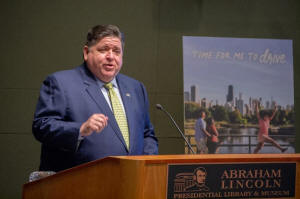Illinois to enter Phase 5, full reopening
 Send a link to a friend
Send a link to a friend
[June 11, 2021]
By PETER HANCOCK
Capitol News Illinois
phancock@capitolnewsillinois.com
 SPRINGFIELD – Starting Friday, Illinois
will be in Phase 5 of the COVID-19 reopening plan, meaning businesses
and organizations can resume normal activity, although some limited
restrictions will remain in place. SPRINGFIELD – Starting Friday, Illinois
will be in Phase 5 of the COVID-19 reopening plan, meaning businesses
and organizations can resume normal activity, although some limited
restrictions will remain in place.
Under Phase 5 guidelines, capacity limits are being lifted for both
indoor and outdoor activities while people who have been fully
vaccinated are no longer required to wear face coverings in most
settings and businesses are no longer required to enforce mask mandates
or maintain social distancing rules, although they may continue to do so
if they choose.
People who have not been fully vaccinated are still encouraged to wear
face coverings, and all people are still required to wear face coverings
while traveling on public transportation, in congregate settings, in
health care settings as well as in schools, day cares and educational
institutions.

Those changes come 15 months after Gov. JB Pritzker first issued a
disaster declaration in response to the pandemic which, as of Thursday,
had infected nearly 1.4 million people in Illinois and claimed 23,014
lives.
Due to the wide availability of vaccines, which first became publicly
available in January, new infections and hospitalization rates have
reached their lowest points since the pandemic began.
The Illinois Department of Public Health reported Thursday that 68
percent of Illinois adults had received at least one dose of vaccine and
51 percent were fully vaccinated.
IDPH also reported Thursday that only 366 new cases of COVID-19 had been
detected in the previous 24 hours. That drove the seven-day average case
positivity rate to just 1 percent, the lowest since the state started
reporting daily test results.
As of late Wednesday night, 764 people in Illinois were reported to be
hospitalized with COVID-19. Of those, 209 patients were in intensive
care units, and 103 of those patients were on ventilators. That was the
lowest number of hospital beds in use since the state began reporting
the numbers as well.
During an interview with Capitol News Illinois last week, Pritzker said
that even though the state was ready to enter the final reopening phase,
he was not yet prepared to lift the disaster proclamation he first
issued on March 9, 2020, which has served as the legal basis behind
scores of executive orders such as a ban on residential evictions and
utility shutoffs. It has been extended monthly since that date.
“It's a new chapter, of course, in the pandemic but we aren't quite
ready yet to remove the disaster declaration,” Pritzker said. “There are
things that need to be ramped down and, you know, making sure of course
that we actually are seeing continued decrease of cases and
hospitalizations.”
[to top of second column]
|

Gov. JB speaks at an event in Springfield in May to
encourage road trips to Illinois. (Capitol News Illinois file photo
by Jerry Nowicki)

The March 9 disaster declaration was followed on
March 15 by an executive order closing K-12 schools to in-person
learning. In the following days Pritzker issued an order closing
bars and restaurants to on-premises service and, on March 20, a
general stay-at-home order that effectively shut down major parts of
the state’s economy.
By April, the state’s unemployment rate had spiked to a modern-day
high of 16.3 percent as tens of thousands of workers each week filed
first-time unemployment claims. But as economic restrictions were
gradually relaxed over the summer, the jobless rate began to
subside, falling to 7.5 percent in October and, most recently, 7.1
percent in April.
Asked during his interview with CNI whether, in retrospect, he
wished he would have handled things differently, Pritzker said he
had to work with the information he had at the time.
“I can tell you that if I knew then what I know now, I'm sure I
might have made some different decisions,” he said. “But that just
wasn't something available to me. What we had was a novel
coronavirus.”
Pritzker added that just a few days before he issued the
stay-at-home order he received projections – a copy of which he said
remains on his desk – that said if the state took no action, Chicago
alone would see 20,000 deaths from COVID-19 by August of that year.
“So we had to make decisions quickly. We had to be decisive about
it,” he said. “I needed to be transparent and communicate at 188
press conferences during the year 2020. And it was my job to not
only give people the facts, but do that in the face of the president
in Washington, D.C., who was lying to people about this. And I think
people needed to hear from somebody, somebody that they would be
willing to listen to, that they trust.”

“And people did the right thing,” he added. “I mean, this is the
amazing thing about Illinois, that we put the mitigations in place,
and then people actually followed them and did the right thing, the
result of which is many, many lives were saved.”
Capitol News Illinois is a nonprofit, nonpartisan
news service covering state government and distributed to more than
400 newspapers statewide. It is funded primarily by the Illinois
Press Foundation and the Robert R. McCormick Foundation. |